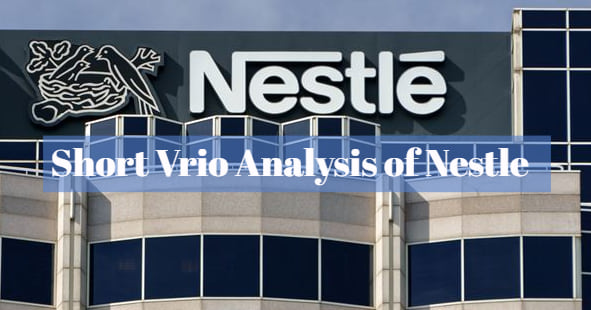In today’s blog post, we will be conducting a VRIO analysis on Nestle, examining its value, rarity, imitability, and organization to gain a better understanding of why the brand has been so successful and identify areas for improvement. So keep reading to find out more about what makes Nestle tick!
Overview of VRIO Analysis
If you want to know whether your organization can achieve a sustained competitive advantage, VRIO Analysis might be the tool you need. The VRIO Framework is a four-pronged analysis of your internal resources and capabilities. It focuses on four criteria – Value, Rarity, Imitability, and Organization. It helps organizations categorize their resources based on whether they hold certain traits that give them a long-term competitive advantage.
Concise but Short Vrio Analysis of Nestle

Valuable Resources of Nestle
The VRIO analysis of Nestle identified its employees as a valuable resource for the company. However, Nestle’s valuable resources are not limited to just its workforce. The company’s diverse portfolio of more than 2000 brands selling in different markets globally contributes significantly to Nestle’s perceived customer value. These brands cater to varying consumer preferences, and this not only increases customer satisfaction but also promotes cross-selling opportunities.
Overall, Nestle’s employees are a crucial component of the company’s success and provide them with a strong competitive advantage in the industry.
Rare Resources of Nestle
Rare resources of Nestle include their strong brand reputation, extensive distribution network, and patent-protected products. Nestle has built a brand name that is recognized globally and is known for its quality products.
The company’s extensive distribution network also sets them apart from their competitors. Nestle has established relationships with wholesalers and retailers that allow them to quickly move their products to market.
Additionally, Nestle has invested a significant amount of money into research and development, resulting in several patent-protected products such as Nespresso and KitKat. These rare resources give Nestle a competitive edge by making it difficult for competitors to replicate their success.
Inimitable Resources of Nestle
Inimitable Resources of Nestle refer to those resources that other companies are unable to copy or imitate, which provides a competitive edge to Nestle. One of Nestle’s inimitable resources is its brand reputation, which has been developed over the years through its commitment to quality products and sustainable practices.
Another inimitable resource is its research and development capabilities, which allows Nestle to continually innovate and stay ahead of competitors.
Nestle’s strong relationships with suppliers and distributors are also inimitable resources as they provide access to unique raw materials and distribution channels.
Non-substitutable/Organization Resources of Nestle
Moving on to the non-substitutable/organization resources of Nestle, it is evident that the brand has certain competencies that are not easily replicable by competitors. These resources of Nestle are unique in nature, giving the company an edge over its rivals.
For instance, the brand’s reputation for quality and trustworthiness is not something that can be readily developed or imitated.
Furthermore, Nestle’s extensive distribution network is also a non-substitutable resource as it takes years to build and requires significant investment. The company’s organizational structure, culture, and human resources philosophy contribute to its core competencies, making it difficult for competitors to imitate. This makes Nestle a formidable player in the market, with a sustainable competitive advantage.
Overall, the combination of valuable, rare, inimitable, and non-substitutable resources makes Nestle a force to be reckoned with in the food industry.
Potential Threats to Nestle’s Resources and Competitive Edge
Despite the strengths and competitive advantages that Nestle holds, they are not invincible to potential threats that could undermine their resources and competitive edge.
One of the biggest threats to their resources is the increasing scarcity of water and poor water quality which could greatly impact their manufacturing processes.
In addition, price fluctuations by retail giants like Walmart could also threaten their financial resources. Furthermore, fierce competition from rivals like Danone and Kraft, who constantly innovate and introduce new products to the market, could pose a challenge to Nestle’s inimitable resources.
These threats emphasize the need for Nestle to constantly adapt and update their strategies in order to maintain their competitive edge.
Final Thought
The VRIO analysis of Nestle Company has provided a comprehensive understanding of the organization’s strategic intent and resources. The valuable financial resources of Nestle have allowed the company to invest in external opportunities and gain a competitive edge in the food industry.
Additionally, Nestle’s 30 major consumer brands have generated billions of dollars in revenue. However, potential threats to Nestle’s resources and competitive edge must be acknowledged and addressed.
Overall, the continued implementation and evaluation of Nestle’s strategic plans will be key to maintaining its position as a leading global food company.
Disclosure: The articles, guides and reviews on BlowSEO covering topics like SEO, digital marketing, technology, business, finance, streaming sites, travel and more are created by experienced professionals, marketers, developers and finance experts. Our goal is to provide helpful, in-depth, and well-researched content to our readers. You can learn more about our writers and the process we follow to create quality content by visiting our About Us and Content Creation Methodology pages.

